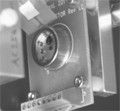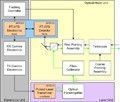-
StatusOngoing
-
Status date2013-11-05
The overall objectives of the OCTAL project can be stated as follows:
- To design an optical communications system for reliable and efficient data relay links through the atmosphere (e.g. UAV to GEO satellite) based on pulse-position-modulation (PPM) and a pulsed beacon laser.
- To design the GEO optical terminal and UAV optical terminal.
- To derive specifications for the Optical Core Unit (OCU) for the UAV-LCT.
- To develop and test the engineering model (EM) of the OCU of the UAV terminal (comprising the pulsed laser transmitter (PLT EM) being developed by LusoSpace and fade tolerant acquisition and tracking sensor (FT-ATS EM) being developed by SensL).
- To design a bread-board of a high-rate multi-pulse PPM communications electronics for extension of the current raw data rate of 25 Mbit/s by at least one order of magnitude
- To verify the PLT and FT-ATS performance in a high-rate optical link under worst-case atmospheric conditions in an inter-island test campaign.

The PLT and the FT-ATS are key units for optical communications through the atmosphere which can be either the OCTAL UAV-GEO link scenario or the units can also be used as key components for e.g. LEO-Ground link scenarios. Both units are ready for further development to flight status. The detailed development roadmap has been elaborated.
Development of key technologies for optical links through the atmosphere.
Figure 1 is the block diagram for the OCU. The OCU comprises the optics, mechanisms and sensors needed to point, acquire and track a laser communications link between the UAV / aircraft and a partner GEO optical terminal.
Figure 1: Block Diagram for the UAV OCU
The OCTAL project is divided into two parts – Part I and Part II. Part I comprises three tasks, namely:
- Task 1 System level design of the optical communications link.
- Task 2 Preliminary design of the optical core unit (OCU).
- Task 3 Space assessment for the critical components.
Part II comprises four tasks associated with the development and testing an engineering model for the OCU. The tasks are:
- Task 4 Manufacturing design of the OCU
- Task 5 Manufacturing, sub-system assembly and integration
- Task 6 Performance verification testing of the OCU
- Task 7 Assessment, recommendations and development roadmap

Completed.






